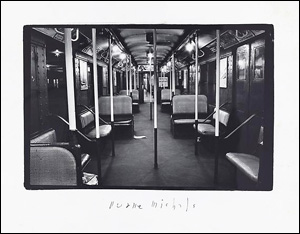12.27.23 — Times, Places, and Media
To continue my year-end review from last time, how then, to go beyond the blockbusters? Of course, the answers are clichés, which means that they are obviously correct and obviously wrong, but start with what they get right.
For starters, look beyond the trends. Not all painters today are into mythmaking and their own bodies. Geometric and gestural abstraction still matter. I did not find the words to review Gallagher, Judith Godwin from postwar years at Berry Campbell, David Novros with his still bold Minimalism at Paula Cooper, or Allison Miller with colliding conventions at Susan Inglett— but I did keep returning to what in such variety will last and what will end up in the trash, and I shall let you follow the links to see.
but I did keep returning to what in such variety will last and what will end up in the trash, and I shall let you follow the links to see.
Then, too, look beyond the hype. That can be especially important with new media, which boast of the latest. At times it could seem that technology is taking over from the artist, like AI for Refik Anadol at MoMA. Video also has the advantage of shouting the loudest and flashing the most lights, like Jacolby Satterwhite in the Great Hall of the Met. Yet Satterwhite and “Signals” at MoMA showed only how much their own narrative leaves out. Artificial intelligence, like the natural kind, can look awfully dumb.
Third, look beyond the times, places, and cultures you know. The Met exhibits both early Buddhist art and Byzantium. In the process, it challenges not just Europe, but the very choices that western art has made. With Byzantium, it relocates the time between the fall of Rome and the Renaissance to Africa and the Middle East, as an evolving dialogue between cultures. Realism or the inhuman, the dark ages or light? Who cares?
Last, look beyond today’s favored media. Not everyone is competing with the past in oil or claiming the future for computer art. What about, say, photography? The fall art fairs added Photofairs New York for just that. The Met followed Berenice Abbott to a city of skyscrapers that you may never have known. Galleries challenged New York to integrate the strangeness of Diane Arbus and Lee Friedlander as well.
Duane Michals, too, flourished in an empty city, but a city of artists. His portraits of Andy Warhol and René Magritte at D. C. Moore had me wondering if he had substituted actors, but no. Warhol looks young and unfamiliar because he was—and still creating his image. With excursions into photography by Jay DeFeo at Paula Cooper, a time and place proved as elusive as abstraction. The International Center of Photography was at its best, too, with the one-on-one between a photographer and a sitter. It sang of “Love Songs” and the artist portraits in “Face to Face.”
ICP ended the year with “Immersion.” It takes an artist’s residency abroad as neither home nor away. Is this the immigrant experience? Yes, but only in part, and that shows the limits of my own clichés. After all the art of immigration and displacement is fashionable, too. My very call to look beyond the trends is a call for diversity, which is trendy as well, and I continue next time with just that.
Read more, now in a feature-length article on this site.